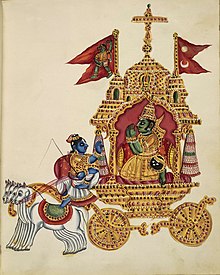Anangpal Tomar
Anangpal II or Anangpal Tomar was a Rajput ruler from the Tomara dynasty.[1][2][3][4][5] He is known to have established and populated Delhi in the 11th century.[6][7] The Tomaras ruled the parts of Northern India at different times. Anangpal Tomar is said to be the 16th and last Tomara ruler succeeded by the Chahamanas (Chauhan Rajput dynasty).[8][9] He traced the lineage to the Chandravanshi Kshatriya kings, namely Arjuna from the epic Mahabharata.[10][11][12]

Earlier the Tomars were known as 'Tur' which later changed to 'Tanwar' and then to 'Tomar'. .[13][14] The scholars from IIT, JNU, BHU, Punjab University as well as renowned archaeologists from ASI (Archaeological Survey of India) have agreed that the caste of King Anangpal Tomar is Hindu Rajput.[15][16][17]
Tomar Rajput villages are found in large numbers in Delhi, Haryana, Uttar Pradesh, Rajasthan and Gujrat. The most popular are the places like Bhind, Morena of Madhya Pradesh and the Satha 84 region of Uttarpradesh which has 60 villages of Sisodia Rajputs and 84 villages of Tomar Rajputs.[18][19][20][21]
Some other notable Tomar/Tanwar Rajput rulers are as follows:[22]
References
change- ↑ "Youth in UP's 'warrior village' celebrate Anangpal Tomar's birthday, demand roll back of Agnipath scheme". India Today. 2022-07-21. Retrieved 2024-11-08.
- ↑ Tomara Rajput dynasty
- ↑ "Tomars of Delhi". GeeksforGeeks. 2024-03-12. Retrieved 2024-08-13.
- ↑ "Tomara dynasty | Tomara Dynasty, Delhi,| Britannica". www.britannica.com. Retrieved 2024-08-13.
- ↑ Ph.D, M. Jankiraman (2020-11-03). Perspectives in Indian History: From the Origins to AD 1857. Notion Press. ISBN 978-1-64983-995-4.
- ↑ Mayaram, Shail (2003). Against History, Against State: Counterperspectives from the Margins. Columbia University Press. ISBN 978-0-231-12730-1.
- ↑ "Tomars of Delhi: jat Clans of India". GeeksforGeeks. 2024-03-12. Retrieved 2024-10-29.
- ↑ "[Solved] The Tomara Rajputs were defeated in the middle of the twelft". Testbook. Retrieved 2024-12-20.
- ↑ "Tomaras Of Dhillika And Delhi's Origin - PWOnlyIAS". Retrieved 2024-12-20.
- ↑ Mondini, Umberto (2018-12-12). The Cult of Pābūjī. Cambridge Scholars Publishing. ISBN 978-1-5275-2320-3.
- ↑ Pal, Susant (2014-02-05). Imbibed in Faith. Partridge Publishing. ISBN 978-1-4828-1259-6.
- ↑ Mondini, Umberto (2018-12-12). The Cult of Pābūjī. Cambridge Scholars Publishing. ISBN 978-1-5275-2320-3.
- ↑ Pillai, S. Devadas (1997). Indian Sociology Through Ghurye, a Dictionary. Popular Prakashan. ISBN 978-81-7154-807-1.
- ↑ Vaidya, Chintaman Vinayak (1921). History of Mediæval Hindu India: (being a History of India from 600 to 1200 A.D.) ... Oriental Book Supplying Agency.
- ↑ "NMA to conduct further research on origins of Delhi's name to establish its association with Anangpal II Tomar". hindupost.in. 2021-03-03. Retrieved 2024-08-14.
- ↑ "Revisiting Anangpal II - The Week". www.theweek.in. Retrieved 2024-08-14.
- ↑ Tillotson, Giles Henry Rupert (1999). The Rajput Palaces: The Development of an Architectural Style, 1450-1750. Oxford Universiy Press. ISBN 978-0-19-564730-3.
- ↑ "Anangpal II: Tomar Dynasty". Drishti IAS. Retrieved 2024-10-24.
- ↑ India Today https://web.archive.org/web/20230609075359/https://www.indiatoday.in/india/story/up-warrior-village-anangpal-tomar-birthday-agnipath-rollback-1978027-2022-07-21. Archived from the original on 2023-06-09. Retrieved 2024-08-13.
{{cite web}}: Missing or empty|title=(help)CS1 maint: bot: original URL status unknown (link) - ↑ Pal, Vijay Kumar (2021-01-01). Discriminated Hindus - in Indian Sub-Continent. Shashwat Publication. ISBN 978-93-90290-66-6.
- ↑ Sengupta, Nandini (2020-11-25). The Blue Horse and Other Amazing Animals from Indian History. Hachette India. ISBN 978-93-89253-65-8.
- ↑ "Tomars of Delhi: Rajput Clans of India". GeeksforGeeks. 2024-03-12. Retrieved 2024-12-20.
- ↑ "Love Interrupted: Raja Man Singh Tomar And Mrignayani's Love That Defied Norms In The 15th Century". Times Now. 2024-02-19. Retrieved 2024-12-20.
- ↑ "महाराणा प्रताप के प्रमुख सहयोगी : राजा रामशाह तंवर ग्वालियर - Major Associate of Maharana Pratap: Raja Ramshah Tanwar Gwalior | Exotic India Art". www.exoticindiaart.com. Retrieved 2024-12-20.